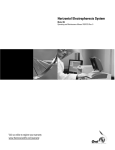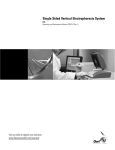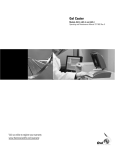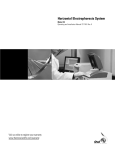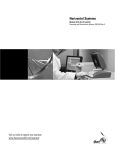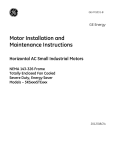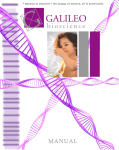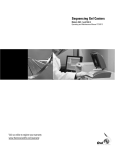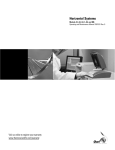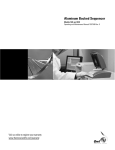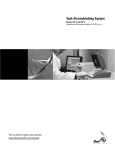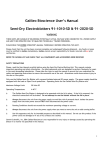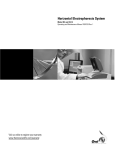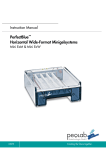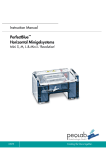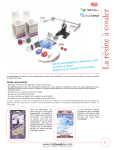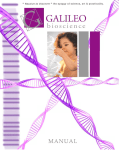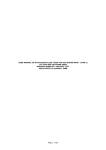Download A2-OK Horizontal System - User Manual
Transcript
Horizontal System Model A2-OK Operating and Maintenance Manual 7219011 Rev. 0 Visit us online to register your warranty www.thermoscientific.com/warranty Preface MANUAL NUMBER 7219011 0 -- 4/13/12 REV ECR/ECN DATE Thermo Scientific Transfer to Marietta (was 11/2002) ccs DESCRIPTION By Horizontal System i Preface Important Read this instruction manual. Failure to read, understand and follow the instructions in this manual may result in damage to the unit, injury to operating personnel, and poor equipment performance. s Caution All internal adjustments and maintenance must be performed by qualified service personnel. s Warning To avoid the risk of personal shock, always disconnect the gel box from the power supply. Further, the power supply must be equipped with a shut-down-on-disconnect circuit. Do not move the unit unless the power source to the unit has been disconnected. s Statement of Proper Use: Use this product only for its intended purpose as described in this manual. Do not use this product if the power leads are damaged or if any of its surfaces are cracked. Warning Running conditions for this unit should not exceed the name plate readings found on the lower buffer chamber. s This Owl System is designed to meet IEC 1010-1 safety standards (IEC 1010-1 is an internationally accepted electrical safety standard for laboratory instruments). Material in this manual is for information purposes only. The contents and the product it describes are subject to change without notice. Thermo Fisher Scientific makes no representations or warranties with respect to this manual. In no event shall Thermo be held liable for any damages, direct or incidental, arising out of or related to the use of this manual. ©2012 Thermo Fisher Scientific. All rights reserved. ii Horizontal System Thermo Scientific Preface Important operating and/or maintenance instructions. Read the accompanying text carefully. Potential electrical hazards. Only qualified persons should perform procedures associated with this symbol. Equipment being maintained or serviced must be turned off and locked off to prevent possible injury. Hot surface(s) present which may cause burns to unprotected skin, or to materials which may be damaged by elevated temperatures. Marking of electrical and electronic equipment, which applies to electrical and electronic equipment falling under the Directive 2002/96/EC (WEEE) and the equipment that has been put on the market after 13 August 2005. This product is required to comply with the European Union’s Waste Electrical & Electronic Equipment (WEEE) Directive 2002/96/EC. It is marked with the WEEE symbol. Thermo Fisher Scientific has contracted with one or more recycling/disposal companies in each EU Member State European Country, and this product should be disposed of or recycled through them. Further information on Thermo’s compliance with this directive, the recyclers in your country and information on Thermo products will be available at www.thermofisher.com. 4 Always use the proper protective equipment (clothing, gloves, goggles, etc.) 4 Always dissipate extreme cold or heat and wear protective clothing. 4 Always follow good hygiene practices. 4 Each individual is responsible for his or her own safety. Thermo Scientific Horizontal System iii Preface Do You Need Information or Assistance on Thermo Scientific Products? If you do, please contact us 8:00 a.m. to 6:00 p.m. (Eastern Time) at: 1-740-373-4763 1-800-438-4851 1-877-213-8051 http://www.thermoscientific.com [email protected] www.unitylabservices.com Direct Toll Free, U.S. and Canada FAX Internet Worldwide Web Home Page Tech Support Email Address Certified Service Web Page Our Sales Support staff can provide information on pricing and give you quotations. We can take your order and provide delivery information on major equipment items or make arrangements to have your local sales representative contact you. Our products are listed on the Internet and we can be contacted through our Internet home page. Our Service Support staff can supply technical information about proper setup, operation or troubleshooting of your equipment. We can fill your needs for spare or replacement parts or provide you with on-site service. We can also provide you with a quotation on our Extended Warranty for your Thermo Scientific products. Whatever Thermo Scientific products you need or use, we will be happy to discuss your applications. If you are experiencing technical problems, working together, we will help you locate the problem and, chances are, correct it yourself...over the telephone without a service call. When more extensive service is necessary, we will assist you with direct factory trained technicians or a qualified service organization for on-the-spot repair. If your service need is covered by the warranty, we will arrange for the unit to be repaired at our expense and to your satisfaction. Regardless of your needs, our professional telephone technicians are available to assist you Monday through Friday from 8:00 a.m. to 6:00 p.m. Eastern Time. Please contact us by telephone or fax. If you wish to write, our mailing address is: Thermo Fisher Scientific 401 Millcreek Road, Box 649 Marietta, OH 45750 International customers, please contact your local Thermo Scientific distributor. iv Horizontal System Thermo Scientific Table of Contents Thermo Scientific Section 1 General Information . . . . . . . . . . . . . . . . . . . . . . . . . . . . . . . . . . . . . . . . . .1-1 Section 2 Setting Up . . . . . . . . . . . . . . . . . . . . . . . . . . . . . . . . . . . . . . . . . . . . . . . . . . .2-1 Preparing the Gel . . . . . . . . . . . . . . . . . . . . . . . . . . . . . . . . . . . . . . . .2-2 Section 3 Using the System . . . . . . . . . . . . . . . . . . . . . . . . . . . . . . . . . . . . . . . . . . . . .3-1 Section 4 Finishing Up . . . . . . . . . . . . . . . . . . . . . . . . . . . . . . . . . . . . . . . . . . . . . . . . .4-1 Specifications and Recommended Running Conditions . . . . . . . . . . .4-1 Section 5 Technical Tips . . . . . . . . . . . . . . . . . . . . . . . . . . . . . . . . . . . . . . . . . . . . . . .5-1 Combs . . . . . . . . . . . . . . . . . . . . . . . . . . . . . . . . . . . . . . . . . . . . . . . .5-1 Reagent Information . . . . . . . . . . . . . . . . . . . . . . . . . . . . . . . . . . . . .5-2 Section 6 Troubleshooting . . . . . . . . . . . . . . . . . . . . . . . . . . . . . . . . . . . . . . . . . . . . . .6-1 Section 7 Care and Cleaning . . . . . . . . . . . . . . . . . . . . . . . . . . . . . . . . . . . . . . . . . . . .7-1 Section 8 Optional Equipment . . . . . . . . . . . . . . . . . . . . . . . . . . . . . . . . . . . . . . . . . . .8-1 Replacement Parts . . . . . . . . . . . . . . . . . . . . . . . . . . . . . . . . . . . . . . .8-1 Horizontal System v Section 1 General Information The Opossum Multiple Gel system is ideal for teaching labs or labs that need to run multiple gels simultaneously. Up to six minigels (7cmW x 8cmL) can be run on this versatile system. Along with optional combs the Opossum can screen up to 144 samples at once (120 with supplied combs). EasyCast casting design allows the casting of gels without tape or plugs. UV transmissible gel trays may be placed directly on the transilluminator for photodocumentation. Before starting, unpack the unit and inventory your order. If any parts are missing, contact Technical Services immediately. Reference the order or catalog number on your invoice and check the corresponding parts list. Table 1-1. Parts List Buffer Chamber Combs 10 well comb, Double Sided, 1.0/1.5mm Thick (12) Super Safe Lid with attached power supply leads Multiple Gel Caster (2) Gel Tray Holder UV Transmissible gel trays (6) Thermo Scientific Horizontal System 1-1 Section 1 General Information Power Supply Leads Gasket (12) Super Safe Lid UVT Gel Tray (6) Gel Tray Holder Multiple Gel Caster (2) Double Sided Comb (12) Buffer Chamber 1.0 Thick 1.5 Thick Bubble Level Figure 1-1. Exploded Parts Diagram Table 1-1. Specifications Gel size . . . . . . . . . . . . . . . . . . . . . . .7cmW x 8cmL Running Buffer . . . . . . . . . . . . . . . . . .Volume 2.3L Footprint . . . . . . . . .28cm W x 37.5cm L x 10cm H 1-2 Horizontal System Thermo Scientific Section 2 Setting Up 1. For shipping and convenient storage, the gel tray is packaged inside the unit with the gasketed end gates in position upon arrival. Lift the casting tray out of the buffer chamber. 2. To cast gels, place the gel tray(s) into the external multiple gel caster. The gasketed sides of the UVT gel tray form a leak proof seal along the side Figure 2-1. Casting Tray of the gel caster. 3. Prepare and pour warm (>60) agarose solution onto UVT gel tray. Place comb(s) into slots provided on walls of UVT gel tray. Figure 2-2. Pour Agarose Figure 2-3. Place Combs 4. One the gel has solidified, place the UVT gel tray (s) into the gel tray holder. 5. Level the casting chamber using the thumbscrews on each side of the unit by slowly turning one thumbscrew at a time and lining up the bubble in the level with the center circle. Place the gel tray holder in the buffer chamber, add buffer, remove combs, load samples and run the gel. Thermo Scientific Horizontal System 2-1 Section 2 Setting Up Preparing the gel - Using electrophoresis-grade agarose and compatible electrophoresis buffer the gel may be prepared in various ways. The percentage of agarose and the electrophoretic buffer used is determined by the size of the samples to be separated and further recovery of the samples. The agarose and buffer are mixed and heated over a heat source, in a microwave oven, or in an autoclave until the agarose is completely dissolved. The prepared gel then must be cooled to below 60° before casting to avoid warping the UVT gel tray due to excessive heat. If numerous gels are to be run in one day, a large volume of gel may be prepared and placed in a covered bottle stored between 40°-60° in a water bath. This provides a ready gel supply in a warm liquid form that will solidify quickly when gels are cast. Pour or pipet warm agarose (<60°). Immediately after pouring, insert the desired comb or combs into the comb slots to form the sample wells. If only a small portion of gel is required for proper sample separation, multiple combs may be used to run 1 or 2 sets of equal distance samples simultaneously expanding the number of samples per gel that may be run. Repeat for up to 6 gels (3 per external multiple gel caster). 2-2 Horizontal System Thermo Scientific Section 3 Using the System 1. Once the gel (s) is completely solidified, lift the gel tray (s) out of the external gel caster. Place the gel tray (s) onto the gel tray holder. Place the gel tray holder in the buffer chamber in the running position. The running position exposes the open ends of the agarose to the buffer. Standard agarose should solidify completely in about Figure 3-1. Place Gel Tray 30 minutes. 2. Pour enough compatible running buffer into the unit to fill the chamber and completely cover and submerge the gel. Correct buffer level is clearly marked on the units side wall as “FILL LINE”. See Recommended Running Conditions for approximate buffer volumes needed for your unit. Too little buffer may cause the gel(s) to dry Figure 3-2. Place Gel Tray Holder out during the run, while excess buffer may decrease DNA mobility and cause band distortion. 3. Carefully remove the comb (or combs) by tapping lightly to loosen, and slowly lifting straight up out of the gel tray to avoid damage to the wells. Thermo Scientific Horizontal System 3-1 Section 3 Using the System 4. Load prepared samples into the wells. Samples should be mixed with a sample loading buffer; giving weight to the samples so that they drop evenly into the wells and containing tracking dyes to monitor the gel run. After the gel solidifies, remove the gel tray from the external casting tray and place the tray on the lab bench. Carefully remove the sample combs by tapping and lifting straight up. Samples mixed with loading buffer that does not contain dye may be easier to load dry, especially in larger gel units to avoid cross contamination. After loading all sample lanes, place the gel tray into the gel tray holder in the running position with the gel edges facing out toward the buffer chambers and slowly fill as described in Step #2. It is wise to always run a sample lane of a known “standard ladder” to determine concentration and size of separated fragments after the gel run, and to aid in photo documentation and analysis. Note It is sometimes easier to load the sample wells dry before placing the gel tray into the running position. 5. Carefully slide the Supersafe lid with attached power supply leads onto the unit. This will connect the power cords to the banana plug electrodes and complete the circuit. Plug other end of the power cords into appropriate power supply. 6. Turn on power supply (see Recommended Running Conditions). Carefully monitor the gel run to avoid samples running into the path of another set of samples. 3-2 Horizontal System Thermo Scientific Section 4 Finishing Up 1. When the gel run is complete and tracking dye has migrated as far through the gel as desired, or to the end of the gel, turn off the power supply and slide off the lid to disconnect from the power source. Carefully remove the tray (s) containing the gel (wear gloves if ethidium bromide is present). The UV Transmissible (UVT) gel tray makes visualization and photography with a UV light source easy without the need to remove the gel from the tray. 2. The gel box should be rinsed under warm running water after each use, including the UVT gel tray (s). Rinsing the UVT gel tray (s) will avoid salt build up in the gasket material from the electrophoretic running buffer, extending the gasket life and ensuring leak-free gel casting. An RNase/DNase decontaminate may be used. This electrophoresis system must never be autoclaved, baked, or microwaved! Specifications and Recommended Running Conditions Gel Size: . . . . . . . . . . . . . . . . . . . . . .7cmW x 8cmL Buffer Capacity: . . . . . . . . . . . . . . . . . . . . . . . . .2.3L There are various types of agarose commerically available that may be used. Besides standard ultra pure electrophoresis grade agarose, there are also numerous low melting point products for easy sample recovery, as well as speciality products formulated for specific uses to separate/recover very small or very large fragments etc. To visualize and photograph the samples after the gel run for a permanent record, the gel may be stained during or following the run with a variety of stains. The most common stain for DNA is ethidium bromide. Ethidium bromide may be added directly to the gel and running buffer to quickly and easily visualize and photograph the separated fragments following the gel run without the need for additonal staining. If this is not added, then following the gel run the gel may also be soaked in a concentrated ethidium bromide solution and rinsed for the same visualization. The ethidium bromide is added to the gel (after heating) and the electrophoresis buffer at a concentration of 0.5ug/ml. Warning Ethidium bromide is a potential carcinogen. Care in handling the powder and stock solution must be taken. Always wear gloves when handling the powder, solutions and all gels that contain any amount of ethidium bromide. s Thermo Scientific Horizontal System 4-1 Section 5 Technical Tips Combs Standard • Standard 1.0mm (C) and 1.5mm (D) thickness for all models. Double Sided • Double Sided Molded Combs combine 1.0mm and 1.5mm tooth thickness on one comb. Double Sided Preparative • One long well and one marker lane. Preparative Wall Comb • See page 33 for details. Multi-Load Comb Wall Comb • F or use with 8 channel pipet. Custom Combs Multi Load Comb Call Technical Services for more information. Thermo Scientific Horizontal System 5-1 Section 5 Technical Tips Reagent Information Chart A Mobility range of DNA in different percentage agarose gels Agarose % (w/v) . . . .Approximate range of separated DNA fragments (kb) 0.3 . . . . . . . . . . . . . . . . . . . . . . . . . . . . . . . . .60 to 5 0.5 . . . . . . . . . . . . . . . . . . . . . . . . . . . . . . . . .30 to 1 0.7 . . . . . . . . . . . . . . . . . . . . . . . . . . . . . . .12 to 0.8 1.0 . . . . . . . . . . . . . . . . . . . . . . . . . . . . . . .10 to 0.5 1.2 . . . . . . . . . . . . . . . . . . . . . . . . . . . . . . . .7 to 0.3 1.5 . . . . . . . . . . . . . . . . . . . . . . . . . . . . . . . .4 to 0.2 2.0 . . . . . . . . . . . . . . . . . . . . . . . . . . . . . . . .3 to 0.1 3.0 . . . . . . . . . . . . . . . . . . . . . . . . . . . . . . . . . . .<0.1 It should be noted, an increased agarose % gives better separation of small fragments and also bands very close together that tend to be more difficult to separate, visualize and photograph. A specialty agarose product formulated to increase resolution of low molecular mass samples may also be used. Example: A good mid-range gel percentage would be 0.7%, or 0.7g. agarose in 100mls. electrophoresis buffer (TBE or TAE), following heating and dissolving the agarose, 10ul of ethidium bromide stock solution (5mg/ml) is added. The gel would be run with compatible electrophoretic running buffer (1X TBE or 1X TAE) that also contained ethidium bromide. 1 liter of the running buffer would contain 100ul of this 5mg/ml ethidium bromide stock solution. 5-2 Horizontal System Thermo Scientific Section 5 Technical Tips Chart B Preparation & Properties of TAE and TBE Electrophoresis Buffer Systems: These buffers are used because they both have a basic pH which gives the phosphate group of the DNA a net negative charge allowing migration of the DNA toward the positive anode in the electrophoresis chamber. TAE - Tris acetate with EDTA (40mM Tris base 40mM acetic acid,1mM EDTA) 50X stock solution, pH 8.5: 1X working solution: 242 g. Tris base 40 mM Tris acetate 57.1 ml. glacial acetic acid 1 mM EDTA 18.61 g. Na EDTA “ 2H2O (MW 372.24) Distilled H2O to 1 liter final volume TBE - Tris borate with EDTA (89mM Tris base, 89mM boric acid, 2mM EDTA) 10X stock solution: 1X working solution: 108 g Tris base 89 mM Tris base 55 g boric acid 89 mM boric acid 7.44g Na2EDTA “ 2H2O (MW 372.24) 2 mM EDTA (or 40 ml 0.5 M EDTA, pH 8.0) Distilled H2O to 1 liter final volume Do not adjust pH Buffer: Suggested Uses and Comments: TAE Buffer Use when DNA is to be recovered. For electrophoresis of large (>20kb) DNA Applications requiring high resolution. Has low ionic strength and low buffering capacity recirculation may be necessary for long runs (> 4hrs). TBE Buffer For electrophoresis of small (<1kb) DNA. Better resolution of small (<1kb) DNA. Decreased DNA mobility. High ionic strength and high buffering capacity - no recirculation needed for extended run times. TBE buffer reacts with the agarose making smaller pores and a tighter matrix. This reduces broadening of the DNA bands for sharper resolution. Thermo Scientific Horizontal System 5-3 Section 5 Technical Tips Ethidium Bromide Ethidium bromide is ideal for the flurometric detection of nucleic acids in gel electrophoresis. The addition of ethidium bromide to both the prepared gel and running buffer is a convenient way to monitor separation and keep a photographic log of gel runs. Ethidium Bromide is prepared as 10mg/ml in distilled water and used as a stock working solution of 5.0ug/ml in the electrophoresis buffer and gel. Mix ethidium bromide powder or tablet thoroughly into solution checking for any precipitate and store at room temperature protected from light. Chart C Amount of Agarose to prepare: All approximate well volumes given in the chart below are based on a gel of 0.5cm thickness. Gel volume is determined by the following formula and may be adjusted according to need or preference: gel width(cm) x gel length (cm) x gel thickness (cm) = ml of agarose Unit Agarose Volume in ml per gel thickness in cm. Model # Gel size(cm) 0.25cm 0.5cm 0.75cm 1.0cm A2-OK Agarose Gel Loading Buffer Samples are prepared and combine with gel loading buffer before applying to the prepared gel. Sample buffer usually contains similar components to the running buffer, dyes for visibility, and glycerol to provide some weight to the samples. This increased sample density and color allows easy visualization of the samples and ensures samples load evenly into the wells and do not float out during loading. Dyes also migrate toward the anode end of the electrophoresis chamber at predictable rates allowing the gel run to be monitored. The most commonly used loading buffer is glycerol, bromophenol blue, and xylene cyanol. 5-4 Horizontal System Thermo Scientific Section 6 Troubleshooting Problem Solution Agarose leaks into chamber when casting the gel Check to see if the gasket is correctly seated in groove and even all the way around. Remove gasket and reseat by smoothing out gently with your thumb from one end to the other. Gasket material may have a tendency to absorb salts from the running buffer. After each use, rinse the end gates under warm running water to bring back spongelike consistence of the gasket material. Gaskets may eventually become brittle with frequent use. Contact Technical Services to purchase replacement gaskets. Check to be sure that the unit is properly leveled for casting and running the gel by using the thumbscrews on the base. Bands seem to be running at Thumbscrews should be adjusted until the bubble in the level an angle. lines up with the levels center circle. Always center the gel tray holder on the platform and cool the agarose to below 60° before pouring to avoid warping the UVT gel tray (s). Samples seem to be running unevenly in certain areas. Check that the platinum electrode wire is intact running flat and evenly across the outer corners and up the side to the junction of the banana plug area. This problem could also be caused by regular casting with very hot agarose gel (>60° ) which may damage the gel tray over time. Always cool the melted agarose to below 60o before casting to avoid warping the UVT gel tray (s). Warping the UVT gel tray will cause all subsequent gels to be cast unevenly. Gels should be no more than 5mm thick and allowed to solidify completely before running. For standard agarose, this would be about 30 minutes, if low melting point agarose is Samples do not band sharply used, it may be necessary to completely solidify gels at a and appear diffuse in the gel. cooler temperature in the refrigerator or cold room. Gels should be submerged in 3-5mm of buffer to avoid gel dry out, but excess buffer >5mm can cause decreased DNA mobility and band distortion. Thermo Scientific Horizontal System 6-1 Section 6 Troubleshooting Problem Solution Bands are not sharp, clear, and even. Always follow the proper procedure for preparing the agarose product according to the manufacturers instructions. When preparing the agarose, be sure all the agarose powder is in solution before heating. In general, add powdered agarose to distilled water and swirl to mix. Make sure all the powder is equally wet to ensure proper melting. Heat in a microwave oven, boiling water bath, or hot plate with occasional swirling to melt and mix completely. Cool agarose liquid to below 60° and cast. Note: Gel should be cast no thicker than 5mm to avoid fuzzy banding. High percentage gels may thicken and solidify rapidly and should be cast while still a liquid. Check that a complete power circuit is achieved between the unit and the power supply. Platinum wire and banana plugs Samples are not moving as should be intact. To test, simply fill the unit with running buffer expected through the gel, remain- and attach to the power supply without a gel or gel tray in the ing in the wells, or diffusing into unit. The platinum wires on both sides of the unit should prothe gel. duce small bubbles as the current passes through. If a complete circuit does not exist, there will be few to no bubbles. Contact Technical Services to schedule a repair. When the comb is removed from the gel, some sample wells are ripped and damaged. Always make sure to allow the gel to solidify completely before moving the gel tray, unit, or removing the comb. To avoid damage to the sample wells, gently rock the comb back and forth lightly to loosen, then slowly pull the comb straight up out of the gel tray. This rocking helps to avoid suction as the comb is removed. Alternatively, once casting is complete, simply submerging the gel with running buffer will help loosen the comb. Using a higher percentage of agarose that forms a tighter gel matrix may remedy this problem as well. The volume of running buffer used to submerge the gel should only be between 3-5mm over the gel surface. Gel should be completely submerged to avoid the gel from drying out, which The gel seems to run slower can smear the bands and possibly melt the gel(s) due to overunder the usual running conditions. heating. If excessive running buffer is added, the mobility of the DNA decreases and band distortion may result. Excess buffer causes heat to build up and buffer condensation inside the unit may result. 6-2 Horizontal System Thermo Scientific Section 6 Troubleshooting Additional Sources for Reference Maniatis T., E. F. Fritsch and J. Sambrook. Molecular Cloning: A Laboratory Manual, Cold Spring Harbor Laboratory, Cold Spring Harbor, NY. Short Protocols in Molecular Biology, - A Compendium of Methods from Current Protocols in Molecular Biology, Edited by Fredrick M. Ausubel, et. al. Adams, D., and R. Ogden, Electrophoresis in Agarose and Acrylamide Gels, Methods in Enzymology, Vol. 152 (1987) Academic Press, Inc. Fotador, U.. Simultaneous Use of Standard and Low-Melting Agarose for the Separation and Isolation of DNA by Electrophoresis, BioTechniques, Vol. 10, No. 2, (1991) Boots, S. Gel Electrophoresis of DNA ; Analytical Chemistry, Vol. 61, No. 8, April 15, 1989 Thermo Scientific Horizontal System 6-3 Section 7 Care and Cleaning Caution Organic solvents cause acrylic to “craze” or crack. Clean all acrylic systems with warm water and a mild detergent. Do not use ethanol or other organic solvents to clean these products. Do not autoclave, bake, or microwave your unit. Temperatures over 50°C can damage the acrylic. s Note If an RNase free electrophoresis system is desired, there are various methods to rid the system of RNA contamination. For fast and easy decontamination, use RNase Away®*. Spray, wipe or soak labware with RNase Away then wipe or rinse the surface clean; it instantly eliminates RNase. RNase Away eliminates the old methods that include treatment with 0.1% Diethyl Pyrocarbonate (DEPC) treated water and soaking in diluted bleach. This electrophoresis system should never be autoclaved, baked, or placed in a microwave. Warning DEPC is suspected to be a carcinogen and should be handled with care. s To order RNase Away®, contact Technical Services: Part Number . . . . . . . . . . . . . . . . . . . . . .Description 7000 . . . . . . . . . . . . . . . . . . . . . . . . . . .250ml bottle 7002 . . . . . . . . . . . . . . . . . . . . . .475ml spray bottle 7003 . . . . . . . . . . . . . . . . . . . . . . . . . . .1 liter bottle 7005 . . . . . . . . . . . . . . . . . . . . . . . . . . .4 liter bottle *Rnase Away® is a registered trademark of Molecular BioProducts Thermo Scientific Horizontal System 7-1 Section 7 Care and Cleaning Care of Acrylic The following chemical compatibility chart is supplied for the convenience of our customers. Although acrylic is compatible with most solvents and solutions found in the biochemical laboratory, some solvents can cause substantial damage. Keep this chart handy to avoid harm to your apparatus by the use of an inappropriate solvent. Codes: S–Safe (No effect, except possibly some staining) A–Attacked (Slight attack by, or absorption of, the liquid) (Slight crazing or swelling, but acrylic has retained most of its strength) U–Unsatisfactory (Softened, swollen, slowly dissolved) D–Dissolved (In seven days, or less) 7-2 Horizontal System Thermo Scientific Section 7 Care and Cleaning Table 5-1. Chemical Compatibility for Acrylic-Based Products Chemical Code Chemical Code Chemical Code Acetic acid (5%) S Ethyl alcohol (50%) A Naptha S Acetic acid (Glacial) D Ethyl alcohol (95%) U Nitric acid (10%) S Acetic Anhydride A Ethylene dichloride D Nitric acid (40%) A Acetone D Ethylene glycol S Nitric acid concentrate U Ammonia S 2-Ethylhexyl Sebacate S Oleic acid S Ammonium Chloride (saturated) S Formaldehyde (40%) S Olive oil S Ammonium Hydroxide (10%) S Gasoline, regular, leaded S Phenol 5% solution U Hydroxide (10%) S Glycerine Heptane (commercial grade) S Soap solution (Ivory) S Ammonium Hydroxide concentrate S Hexane S Sodium carbonate (2%) S Aniline D Hydrochloric acid (10%) S Sodium carbonate (20%) S Benzene D Hydrochloric acid concentrate S Sodium chloride (10%) S Butyl Acetate D Hydrouoric acid (40%) U Sodium hydroxide (1%) S Calcium chloride (saturated) S Hydrogen peroxide (3% solution) S Sodium hydroxide (10%) S Carbon tetrachloride U Hydrogen peroxide (28% solution) U Sodium hydroxide (60%) S Chloroform D Isooctane S Sodium hydrochlorite (5%) S Chromic acid (40%) U Isopropyl alcohol (100%) A Sulfuric acid (3%) S Citric acid (10%) S Kerosene (no. 2 fuel oil) S Sulfuric acid (30%) S Cottonseed oil (edible) S Lacquer thinner D Sulfuric acid concentrate U Detergent Solution (Heavy Duty) S Methyl alcohol (50%) A Toluene D Diesel oil S Methyl alcohol (100%) U Trichloroethylene D Diethyl ether U Methyl Ethyl Ketone U Turpentine S Dimethyl formamide U Methylene chloride D Water (distilled) S Dioctyl phthalate A Mineral oil (white) S Xylene D Ethyl acetate D This list does not include all possible chemical incompatibilities and safe compounds. Acrylic products should be cleaned with warm water, a mild detergent such as Alconox™, and can also be exposed to a mild bleach solution (10:1). In addition, RNAse removal products are also safe for acrylic. Contact Technical Services with any questions. Thermo Scientific Horizontal System 7-3 Section 8 Optional Equipment Leveling Platform The three point leveling platform, Model B-LP, ensures a flat casting and running surface. the platform is 46cm x 36cm and is large enough to fit most applications. One bubble level (BBL-1) is included. Contact Technical Services to order replacement parts. Table 8-2. Replacement Parts Cat. No. . . . . . . . . . . . . . . . . . . . . . . . . .Description PSL-5 . . . . . . . . . . . . . . . . . . . .Power Supply Leads B1A-UVT . . . . . . . . . . . . . . .Gasketed UVT gel tray B1A-CST . . . . . . . . . . . . . . . . . .Multiple Gel Caster A2-OT . . . . . . . . . . . . . . . . . . . . . .Gel Tray Holder B1A-GK . . . . . . . . . . .Replacement Gaskets (1 pair) Combs Thermo Scientific Catalog # # of teeth Tooth Width (mm) Thickness (mm) B1A-5C 5 11 1.0 B1A-5D 5 11 1.5 B1A-6 6 9 1.5/1.0 B1A-8 8 6 1.5 /1.0 B1A-10 10 5 1.5 /1.0 B1A-12 12 3.5 1.5 /1.0 B1A-PREP 2 57/4.8 Horizontal System 8-1 Thermo Scientific Rev. 0 9/12 REGISTERED ISO 9001 If equipment service is required, please call your Technical Services Department at 1-800-438-4851 (USA and Canada) or 1-740-373-4763. We’re ready to answer your questions on equipment warranty, operation, maintenance, service, and special applications. Outside the USA, contract your local distributor for warranty information. Your local Thermo Sales Office is ready to help with comprehensive site preparation information before your equipment arrives. Printed instruction manuals carefully detail equipment installation, operation and preventive maintenance. THIS WARRANTY IS EXCLUSIVE AND IN LIEU OF ALL OTHER WARRANTIES, WHETHER WRITTEN, ORAL, OR IMPLIED. NO WARRANTIES OF MERCHANTABILITY OR FITNESS FOR A PARTICULAR PURPOSE SHALL APPLY. Thermo shall not be liable for any indirect or consequential damages including, without limitation, damages to lost profits or loss of products. Replacement or repair of component parts or equipment under this warranty shall not extend the warranty to either the equipment or to the component part beyond the original warranty period. The Technical Services Department must give prior approval for return of any component or equipment. At Thermo’s option, all non-conforming parts must be returned to Thermo postage paid and replacement parts are shipped FOB destination. During the first thirty-six (36) months, component parts proven to be non-conforming in material or workmanship will be replaced at Thermo’s expense, including labor. Installation, calibration and certification is not covered by this warranty agreement. The Technical Services Department must be contacted for warranty determination and direction prior to performance of any repairs. Expendable items, glass, filters and gaskets are excluded from this warranty. The Warranty Period starts two weeks from the date your equipment is shipped from our facility. This allows shipping time so the warranty will go into effect at approximately the same time your equipment is delivered. The warranty protection extends to any subsequent owner. THERMO FISHER SCIENTIFIC OWL PRODUCTS WARRANTY USA Section 9 Warranty Information Horizontal System 9-1 9-2 Horizontal System Rev. 0 9/12 REGISTERED ISO 9001 If equipment service is required, please call your Technical Services Department at 1-800-438-4851 (USA or Canada) or 1-740-373-4763. We’re ready to answer your questions on equipment warranty, operation, maintenance, service, and special applications. Outside the USA, contract your local distributor for warranty information. Your local Thermo Sales Office is ready to help with comprehensive site preparation information before your equipment arrives. Printed instruction manuals carefully detail equipment installation, operation and preventive maintenance. THIS WARRANTY IS EXCLUSIVE AND IN LIEU OF ALL OTHER WARRANTIES, WHETHER WRITTEN, ORAL, OR IMPLIED. NO WARRANTIES OF MERCHANTABILITY OR FITNESS FOR A PARTICULAR PURPOSE SHALL APPLY. Thermo shall not be liable for any indirect or consequential damages including, without limitation, damages to lost profits or loss of products. Replacement or repair of component parts or equipment under this warranty shall not extend the warranty to either the equipment or to the component part beyond the original warranty period. The Technical Services Department must give prior approval for return of any component or equipment. At Thermo’s option, all non-conforming parts must be returned to Thermo postage paid and replacement parts are shipped FOB destination. During the first thirty six (36) months, component parts proven to be non-conforming in material or workmanship will be replaced at Thermo’s expense, excepting labor. Installation, calibration and certification is not covered by this warranty agreement. The Technical Services Department must be contacted for warranty determination and direction prior to performance of any repairs. Expendable items, glass, filters and gaskets are excluded from this warranty. The Warranty Period starts two months from the date your equipment is shipped from our facility. This allows shipping time so the warranty will go into effect at approximately the same time your equipment is delivered. The warranty protection extends to any subsequent owner. THERMO FISHER SCIENTIFIC OWL PRODUCTS WARRANTY INTERNATIONAL Section 9 Warranty Information Thermo Scientific Thermo Fisher Scientific 401 Millcreek Road Marietta, Ohio 45750 United States www.thermofisher.com

































